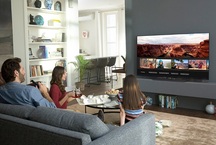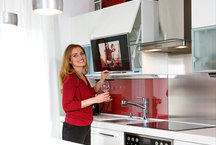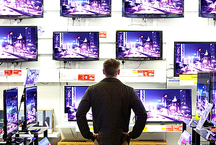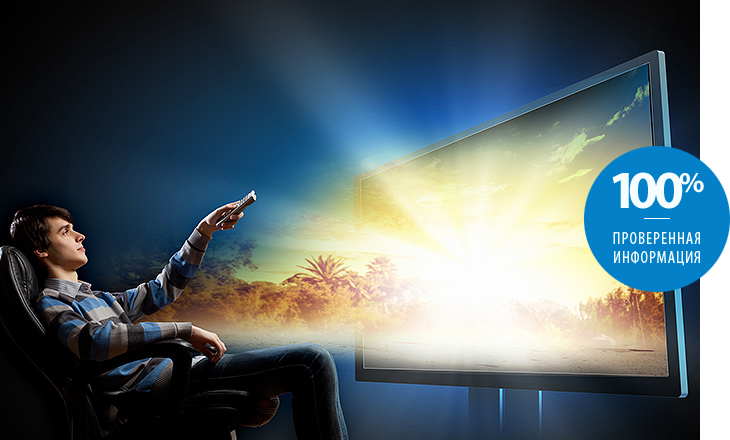
In the 20th century there was nothing difficult in choosing a television. All of them differed only in the diagonal of the kinescope and the number of memorized TV channels. In short, in those days, the consumer was guided only by the thickness of his wallet. Now the situation has changed. Some TVs get so many functions that they can easily be compared with a computer! At such moments, a person needs to understand, but does he need such a wide functionality? Keep in mind should be some other points. About all of them will try to tell this material. If you carefully read this article, then with the selected TV just will not lose!
Screen diagonal
As before, the choice of TV now begins with an assessment of the room where it will be placed. If the device is purchased for a huge living room, then it must have a screen with a diagonal greater than 50 inches. The meter TV will be clearly visible, it will become a real decoration of the room. If it is bought for a bedroom, then the size does not play a big role. In the case of buying a TV for a child's room, you should already pay attention to the quality of the picture. Try to choose a device with a good screen resolution - then your child will not spoil the vision. As for the size of the display, it should not be large. Why indulge children from a younger age?
It should be noted here that large-screen TVs can cost completely different money. It so happens that the price of modern technology is influenced by many factors, the diagonal is just one of them. Therefore, you need to determine in the shortest possible time whether the size of the display is a priority for you. And take a look at the amount you have. If you are limited in finance, then you will find a very difficult choice. You can buy an inexpensive TV by limiting yourself in functionality, or you can buy a device with support for a large number of technologies, but with a small screen.
You should also pay attention to the quality of the display. Low-cost models may have minimal viewing angles. If, when viewed from the side, the picture does not have any special distortions, then a look from above or below will immediately reveal a lot of defects. Regularly in stores there are also defective TVs, which have broken pixels. They are black burnt dots, clearly visible when a uniform color mass is displayed on the screen. When choosing a TV should pay attention to the backlight. Sometimes it can spoil the whole impression when viewing a dark image - black colors will be flooded with white light. This can also be attributed to marriage - a good TV has the backlight as evenly as possible.
Display resolution
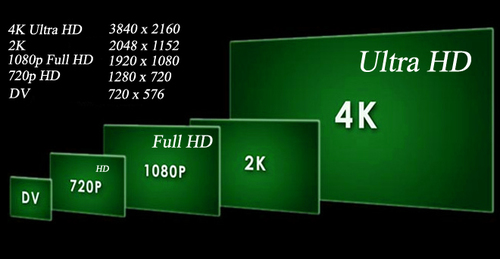
The screen resolution of the first LCD TVs was very low. Now on sale you can find devices with 4K-display! Therefore, be sure to think about how you need a quality picture.
1366 x 768 pixels
The cheapest TVs, whose price is less than 10 thousand rubles, are endowed with HD-resolution. If you are not going to connect a Blu-ray-player and watch high-definition movies, then this is quite enough. Digital TV now broadcasts precisely in HD-resolution, which is ideal for such TVs. For example, on more expensive TVs, watching HD channels is already more difficult - the picture is blurring, albeit quite a bit.
1920 x 1080 pixels
If you are going to watch Hollywood products regularly, then the usual HD you quickly will be a little. In this case, it is better to look at the TV itself, which is able to please full-fledged Full HD.This resolution does not affect the diagonal - now you can find similar TVs of any size. If you don’t notice much improvement when watching TV channels compared to a traditional HD screen, when you connect a Blu-ray player, everything will change. And do not forget that on the Internet now you can find a lot of movies in the resolution of Full HD. But most of all, such a TV is necessary for those who have devices that can shoot video. For example, almost all modern video cameras write a picture at a resolution of 1920 x 1080 pixels. Many cameras and smartphones are also capable of this.
3840 x 2160 pixels
4K TV is recommended for anyone who wants to be at the forefront of technological progress. Some people believe that the difference from Full HD will be noticeable only by direct comparison. But such experts simply were not in the store and did not see 4K TV with their own eyes. Such devices display a better picture - this can be clearly seen even when it is viewed from a distance of 3-4 meters. The disadvantage of such TVs is the minimum amount of existing 4K content. New Blu-ray-discs will be available only in early 2016, and this is still an optimistic forecast. On the Internet, movies and TV series of higher definition are also a rarity. You should also be prepared for the fact that analog and digital TV is very difficult to watch on such devices - the picture stretches several times, and cannot do without the “soap” effect.
3D and Smart TV
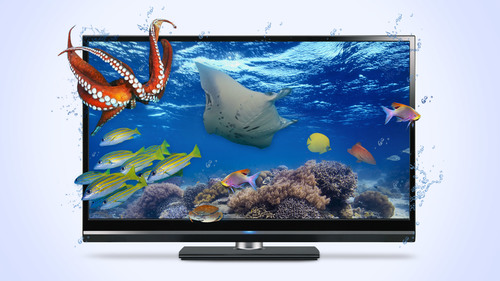
If you are going to buy a TV for the kitchen, you can skip this chapter. This also applies to those people who want to put a purchase in the children's room. But everyone else should reflect on whether they need two modern functions. The first allows you to watch three-dimensional content - usually for this it is necessary to wear shutter or polarized glasses. The second is a kind of operating system - the user is given the opportunity to install applications, expanding the functionality of the TV.
3D TVs are always more expensive than their simplified counterparts. This is due to the fact that they are equipped with glasses (a separate purchase of which will cost 400-2000 rubles), and their screen can be supplemented with a special coating (this does not apply only to TVs with shutter glasses). If you need a model with a small screen, then do not even think about 3D - you will use this function only a couple of times, as an experiment. 3D support is required only if the screen size is 40 inches or more.
As mentioned above, there are two of the most popular ways to display 3D. Active technology works with shutter glasses. The picture on the televisions supporting it is replaced with a frequency of 120 frames / s or even higher. Half of the frames are for the left eye, half for the right. The glasses have shutters that do not allow to see that frame that is not intended for it. As a result, 3D content seems to be voluminous. The lack of technology - in expensive glasses. They can also cause a feeling of heaviness when watching a movie for a long time - because they have active cells and batteries.
Passive technology works easier. The television she endowed has a special coating on the display. With it, the picture seems to split apart. The lenses of compatible glasses let through certain light waves. As a result, one eye will not see what is intended for the second. The disadvantage of this solution is that the image resolution is halved. Sometimes it is noticeable, and in other cases it does not bother you at all. And still the picture may seem dark - the lenses of glasses refract part of the light flux.
What type of display 3D-pictures you need and whether you need at all - you choose. As for Smart 3D, this technology allows you to download content from the Internet, bypassing the intermediate links in the form of a laptop, desktop PC or smartphone.If you regularly watch such content, then the Smart TV function will definitely not hurt you. The trouble is that in different TVs it is implemented with varying degrees of success. Therefore, do not forget to check the operation of this technology in the store or read an overview of the selected model.
Connectors
The number of connectors is worth paying if you have a large number of electronic devices. Or if you plan to buy them in the future - because the TV is not bought for one year. Pay special attention to the number of HDMI connectors. It is to them connects most of the equipment that works with the image in the resolution of Full HD or 4K. Two of these connectors are enough for those who do not plan to connect to the TV a lot of devices. If you are going to regularly connect a laptop, video camera, game console and Blu-ray player, then you should look towards TVs with four HDMI connectors.
You should also familiarize yourself with the number of USB ports the device you are interested in. You will need at least one at least - a flash drive with the content stored on it will be connected to it. If the TV has Smart TV support, then two additional ports will come in handy. They can be used to connect an external hard drive and a computer mouse, which will simplify the control of the cursor in the browser.
Digital tv

Now analog TV is gradually being supplanted by digital. On the territory of Russia, for several years already, two Multiplex satellites have been operating, thanks to which digital channels are caught on a conventional antenna. However, for these purposes, the TV must have support for the DVB-T2 standard. Now it makes no sense to consider models without this support - you do not want to then purchase an additional device in the form of a TV set-top box?
If you are planning or have already connected to satellite TV, then it is desirable to have support for a DVB-S2 standard TV. This will allow you to abandon the receiver by directly connecting the cable that extends from the satellite dish. But keep in mind that these TVs are more expensive than others.
Scan
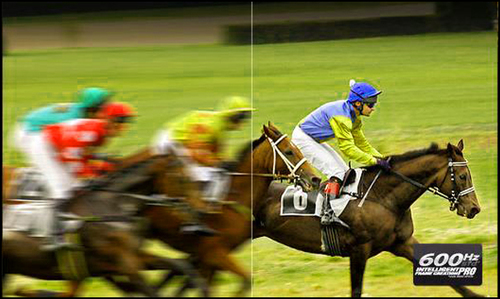
Under scan understand the ability of the TV to change frames with a certain speed. In particular, the cheapest models have a 60 Hz sweep rate - the image in this case is displayed at a speed of 60 frames / s. This is a good indicator for a computer monitor, but not for a TV. Now you can easily find cheap models that have a screen with a frequency of 100 to 200 Hz. Action scenes on these TVs look very smoothly. But for devices with support for shutter 3D, this may not be enough, so they are endowed with a display with even faster scanning - in this case, the eyes no longer feel the flickering effect.
In short, do not underestimate this parameter. The higher it is - the smoother and better picture you get. Unfortunately, the scan directly depends on the cost of the TV. Now there are TVs on display that display a picture with a speed of as much as 1000 Hz, but they are extremely expensive.
Other selection criteria
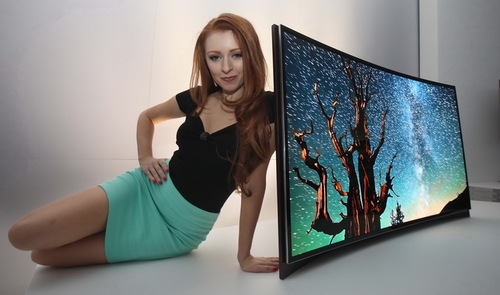
Photo: hsto.org
Wi-Fi
If you choose a TV with the support of Smart TV technology, then you have to attend to the method of accessing the Internet. You can connect the device to the router with a cable. But the wireless connection is much more convenient. Unfortunately, not every TV has built-in support for Wi-Fi - sometimes it needs to connect a proprietary adapter that costs fabulous money. Therefore, be sure to check if the model you are interested in has a built-in Wi-Fi chip.
Response time
This parameter is very important for any gamer. If you connect a game console or computer to a TV, the response time should not exceed 5 ms. Otherwise, sports simulators and games of some other genres will be displayed with artifacts in the form of loops stretching after fast moving objects.
Webcam
Smart TV is not only the ability to download content from the Internet.This technology allows you to install on the TV also Skype. However, the usual webcam device is not recognized. In the instructions, manufacturers specify what kind of webcam is required for the TV. This is usually a special model sold at a very high price. If you are going to communicate with relatives and friends right from the couch, then it is better to purchase a TV with an integrated webcam - this will save you time, nerves and money. Also, such models can support the management of gestures - some people like this way of changing channels and changing the volume level.
Most popular TV manufacturers
LG
Those born in the USSR remember the Goldstar color television sets. They were made back in the days when this brand was owned by the company of the same name. But then there was a takeover, and the association created was called LG. Now the TVs of this company have an adequate price tag and quite good functionality. There are also experimental and elite models that have a 4K or even 8K display. LG is one of the few companies that have relied on 3D passive technology.
Philips
Netherlands company Koninkijke Philips N.V. was founded in 1891. After some time, management decided to go in three ways, making a course for lighting solutions, health care and consumer goods. In 1925, the first televisions began to go off the assembly line, after which their production did not cease for many years. However, in 2013, the company sold 70% of its television business to TP Vision. And in January of the following year, the remaining share in the joint venture was sold. Therefore, now Philips TVs have nothing to do with the Dutch company - it only receives license fees for using its brand. However, this does not make TVs bad - after all, TP Vision has received all the modern technologies that used to belong to the company from Eindhoven.
Samsung
The South Korean group of companies Samsung is well known to fans of electronic technology. However, it is involved not only in the production of these devices - South Koreans are also present in the aircraft industry, shipbuilding, chemical, financial and entertainment industries. As for TVs, the concern set up their creation many years ago. Unfortunately, now they are not in stable demand, which is why the TV division is suffering losses. However, this does not prevent the technique to please its customers.
Sony
The Japanese company Sony was founded on May 7, 1946. She began her story with the production of radios. In the future, it began to create all new devices, including electronic ones. Televisions have not been forgotten either. For a long time, they had a unique design that consumers loved. In Sony, almost longer than the rest relied on plasma models. The company now produces LCD TVs with a high-quality screen and a pleasant appearance. The most popular models are with support for Smart TV and 3D (active technology is involved).
Sharp
The Japanese company Sharp was founded back in 1912. At first, she made all sorts of unique little things. For example, a mechanical pencil that did not require sharpening was very popular among consumers. Thanks to him, the company got its name. In the future, the manufacturer has relied on the emerging market of radio receivers. And now excellent LCD screens are coming off the assembly line of its factories. They are supplied to other companies as well as to their own TV-making division.
Mystery
Mystery Electronics is primarily focused on the production of speakers and radio tape recorders designed for use in cars. It was founded in Hong Kong about fifteen years ago. Now the company is trying to expand production, as well as penetrate new markets for themselves. On the shelves of the respective stores you can easily find GPS-navigators, stereos, DVRs and even Mystery TVs.The latter are trying to offer good quality pictures at a low price. Some models have a tiny display, making it possible to install them in a car.
Supra
Equipment under the Supra brand is in decent demand both in the CIS and in some European countries. This is due to its low cost - this is what the company management has relied on. If you are looking for a budget TV, then with a high degree of probability you will make a choice in favor of Supra.
Rubin
The Rubin plant, located on the territory of Moscow, produced its first television set in 1952. Gradually, skilled engineers developed the North, Ekran, Moscow, Almaz and some other models. Since 1957, the Ruby TV has started to go off the assembly line. Now the production of such equipment has been moved to Voronezh. From the kinescope products the company has long refused - instead, high-quality LCD TVs are produced. Many models for very little money provide support for the DVB-T2 digital standard and USB port.
BBK
The Chinese company BBK was founded in 1995. In a short time, she was able to find her niche by producing budget DVD players. Products quickly gained popularity not only in the home market, but also in Russia. Now on the shelves of shops you can find LCD TVs BBK, characterized by low price and sturdy construction. However, it should be remembered that the Chinese regularly save on some components, therefore, many years of service can not be counted on.
Panasonic
The Japanese company Panasonic was born on March 18, 1918. Her story began with the production of radio National. Now its range includes many products. The company succeeds best of all with video cameras and small household appliances (electric razors, hair clippers, epilators, etc.). Buyers do not complain about Panasonic TVs either. They are pleased with a good design and high-quality display.
Goldstar
Under the brand GoldStar now produces a large number of household appliances - from fans to TVs. First of all, any device pleases with its price. Goldstar TVs are regularly improved - a scientific laboratory, which is part of the manufacturer, is working on the new functionality. However, it should be borne in mind that all the equipment under this brand is in no way connected with the famous company that became a part of LG in the 90s of the last century.
Rolsen
The Russian company Rolsen Electronics was born in 1994. She specializes in the production of video, audio and home appliances. Sometimes this is done for world-famous enterprises - Toshiba, Daewoo, Hitachi and JVC. Off-line and products under its own brand. In particular, Rolsen TVs, which have not the highest price tag, have proven themselves well. Production of almost all of the equipment takes place in the Kaliningrad region. The company also has a plant in the suburban town of Fryazino.
Jvc
The JVC brand is familiar to many of us from old camcorders and VCRs. It is owned by Japan Victor Company Ltd. - an enterprise founded in 1927. After the collapse of the USSR, it was easy to find JVC CRT TV sets on the shelves of our stores. Now it produces models based on the LCD panel. Usually, such products force to attract attention due to an adequate pricing policy.
Dexp
DEXP is based in Vladivostok and was founded in 1998. Initially, she was engaged in assembling desktops and professional systems integration services for businesses. The assembly of laptops and the production of television sets started only in the late 2000s. Technique DEXP different well-chosen price tag and high-quality assembly.
